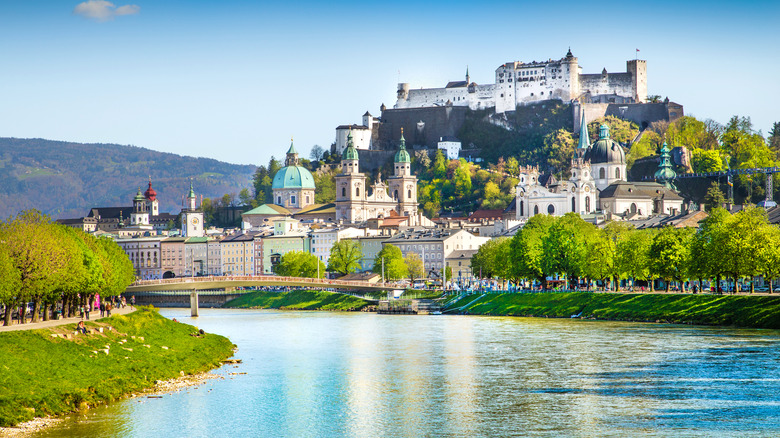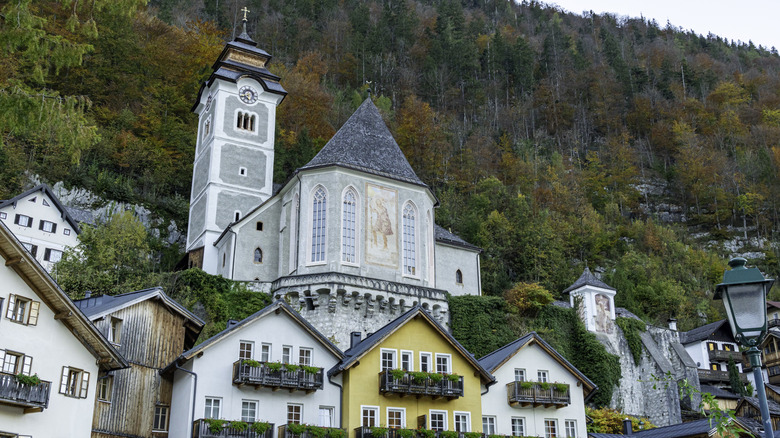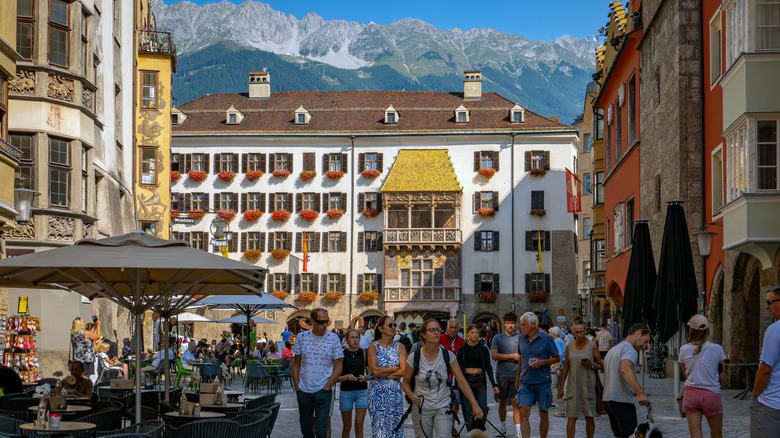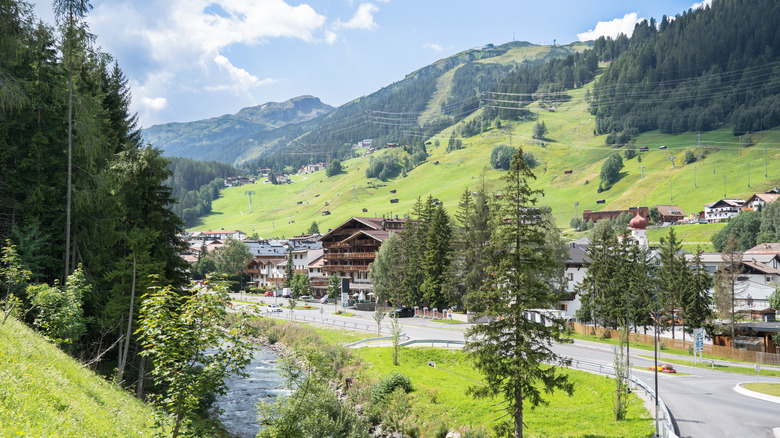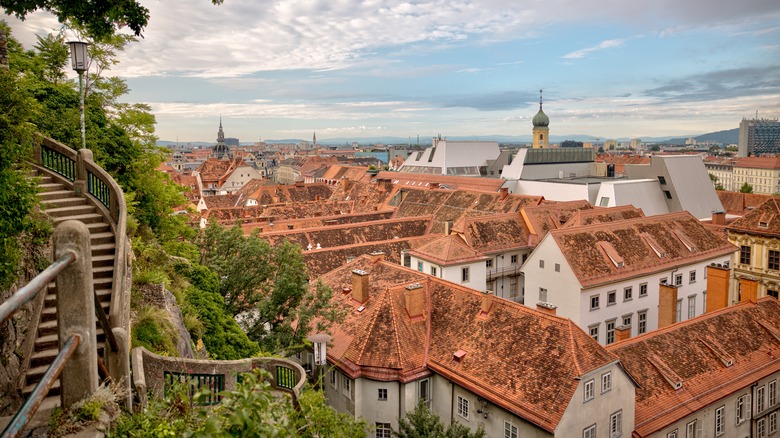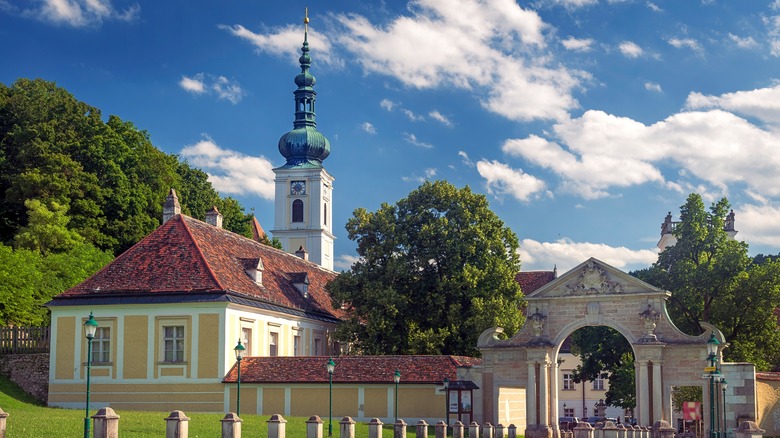Austria's 10 Best Attractions And Destinations For First-Time Visitors
Every corner of Austria feels like it could have been taken from the pages of a storybook. It's a nation where imperial palaces still stand guard over cities, the Alps serve as the backdrop to everyday activities, and incredible history exists at every turn. Among many interesting factoids about Austria is that it's home St. Peter's Stiftskelle, Europe's oldest operational restaurant! And, travelers can even visit the world's first zoo. Often called the Land of Music, Austria is the homeland of Mozart, Strauss, and many more musicians who have created masterpieces through the ages.
In this guide, we'll travel to 10 destinations that should absolutely be on your list for your first trip to Austria. We'll check out the luxe life in Vienna, then venture to the birthplace of "The Sound of Music," and then trek into the mountainside villages of the Alps. Austria is one of the best European nations for hiking. Whether you're drawn to Austria's refined culture and fascinating history, or the natural scenery is calling your name, this guide will help you craft your very own fairytale vacation through everything that Austria has to offer.
Vienna
As the capital of the country, Vienna is arguably Austria's crown jewel. Once the base of the powerful Habsburg Empire, which ruled from the 13th century until 1918, Vienna was the birthplace of Marie Antoinette. Long before she became France's infamous queen, she grew up here, the youngest daughter of Holy Roman Emperor Francis I and Habsburg Empress Maria Theresa. A must-see is the stunning Schloss Schönbrunn (Schönbrunn Palace), the summer residence of the Habsburgs during Maria Theresa's reign. Your ticket includes an audio guide that will help you navigate the UNESCO-designated palace and gardens. Highlights during the tour include Franz Joseph's private living quarters, Maria Theresa's apartments, and the Marie Antoinette dining room. Families, in particular, are also invited to visit the Children's Museum at the palace, where guests are immersed in the world of the Habsburg children.
For music lovers, Vienna is a dream destination. Many classical greats, including Mozart, Strauss, Beethoven, Schubert, and Mahler, lived and worked in the city under the Habsburgs' patronage. Today, an evening at the Vienna State Opera offers a world-class cultural experience, with well-known performances like "Faust," "Don Giovanni," and "Falstaff" regularly on the schedule. Visitors can also indulge in a night with the Vienna Royal Orchestra, which performs classic Viennese music. Don't leave without experiencing Vienna's famous café culture, which has been part of the city's heritage for centuries. Transport yourself to bygone eras in ornate coffeehouses like Café Central or Frauenhuber, the oldest coffee shop in the city. Order a slice of the Austrian treat sachertorte, and soak up Vienna's atmosphere as writers, artists, and great intellectuals once did.
Salzburg
Salzburg is a place where music, mountains, Baroque architecture, and cinematic history converge. Best known as the birthplace of Wolfgang Amadeus Mozart, where he fell in love with music before moving to Vienna, and as the iconic filming location of "The Sound of Music," this river city is a must-visit during your first trip to Austria. To truly immerse yourself in Salzburg's movie heritage, join an official "Sound of Music" tour, where you'll visit the 1959 film's most iconic locations while discovering behind-the-scenes trivia and learning about the actual Von Trapp family. One of the things you'll do is stroll through Mirabell Gardens and visit the Pegasus Fountain, where Julie Andrews famously sang "Do-Re-Mi." You'll also see Schloss Leopoldskron, which served as the Von Trapps' home in the film but is now a five-star hotel. And, of course, you'll visit the church where Maria and the Baron wed!
There are plenty of things to do in Salzburg that aren't related to the "Sound of Music," though the film is a major draw for tourists. Salzburg's Old Town, a UNESCO World Heritage Site, offers ornate churches, walkable corridors, and a plethora of restaurants. Alter Fuchs is known for its authentic Austrian dishes, like schnitzel and goulash. Michelin-starred Riedenburg serves Old Town visitors a contemporary take on Austrian classics; its guinea fowl crêpes come highly recommended. To see the city from above, book a funicular ride to the Hohensalzburg Fortress, Europe's largest castle complex. Construction began in the 11th century and has seen many updates; its current design is owed to a 1500 renovation. Highlights at the Fortress include touring the Princes' Chambers, the historic military Arsenal, and the Marionette Museum.
Hallstatt
Few places in the world are as breathtaking as the village of Hallstatt. Situated between an Alpine lake and mountains, this picturesque spot is rumored to have inspired Arendelle, Anna and Elsa's fictional kingdom in Disney's "Frozen." The association led to a tourism surge for the town of 800 residents. With its famous brightly-colored houses, every pathway here will make you feel as if you've stumbled into a painting. Travelers in the know suggest looking for staircases between houses, leading up to the next street. As Hallstat grew, it spread up, not out, as a result of the rock and water barriers on either side. For a bite to eat after exploring, there are plenty of options. The Rudolphsturm Restaurant (closed for renovations at the time of publication) at Vitalhotel Gosau is a popular option. Many travelers also rave about the view at Seecafe Hallstatt.
Don't miss the Salzwelten, the Hallstatt salt mines, which are among the oldest in the world. During a guided tour of the Salzwelten Altaussee, the biggest active mine, guests will experience tunnels and passageways, a chapel, and a subterranean salt lake. The highlight is sliding down two of the miners' original chutes! Aboveground, book a boat ride on Hallstätter See (Lake Hallstatt) to enjoy stunning views. And, for something truly unique — and slightly macabre — to round out a trip to Hallstatt, visit the Bone House (Beinhaus), where 1,200 intricately painted human skulls are displayed. The skulls are from bodies that were exhumed from graveyards due to overcrowding, then painted with motifs that symbolize everything from glory (oak) to love (roses). Families typically arranged the skulls of their relatives together to preserve their memory. Although most of the "newer" skulls were painted in the early 19th century, there are some 20th-century examples!
Innsbruck
Innsbruck is unique in that it is an Alpine playground for skiers and snowboarders, while simultaneously carrying the weight of a sad history. Annexed by Nazi Germany in 1938 and bombed 22 times by Allied forces, the city has rebuilt itself into one of Austria's loveliest destinations. Innsbruck has hosted the Winter Olympics twice, in 1964 and 1976, and it remains a hotspot for winter sports enthusiasts. Popular resorts here include Kühtai, which is the highest altitude resort in Austria, and the famous Stubai Glacier. For beginners and families with small children, the lifts at the Archenstadllift Rinn, KühTeppich, and Sonnenberg resorts are highly recommended. This Austrian Alps mountain town truly has endless trails to explore.
Off the slopes, visitors should start their excursions in the Altstadt neighborhood (Innsbruck's Old Town). This is where the iconic Golden Roof is located. This landmark was originally a residence, built in the 16th century. The balcony under the gilded awningserved as a royal balcony for Habsburg Emperor Maximilian I during his reign. Additionally, tourists can view the impressive tomb of Maximilian, ordered by his grandson at the Court Church in Old Town's palace complex. Ambras Castle is also worth a stop. Built by another Habsburg, Ferdinand II, for his wife, the castle today features a collection of armor, art, and family portraits from the Habsburg dynasty. From there, take the Hungerburg Funicular, a sleek cablecar system that opened in the 1920s but was redesigned by Zaha Hadid in 2007. The funicular takes travelers from Innsbruck's city center into the mountains above. From the top, travelers can take photos and enjoy incredible views of the Austrian Alps.
Melk Abbey (Wachau Valley)
Built on a hill above the Danube River, Melk Abbey is one of Europe's most stunning examples of Baroque architecture. Built in the 18th century, this Benedictine complex is one of the most important landmarks in Austria's Wachau Valley. The Abbey is impossible to miss with its golden-yellow façade and 1,050-foot length. As striking as the exterior is, the interior is even more so. During a standard tour, visitors can explore the Marble Hall and its frescoes, the staircase, and the abbey church. Throughout the year, there are special events like a summer concert series and the International Baroque Days festival. The most impressive feature of Melk Abbey, though, is its world-renowned library, which is home to over 100,000 medieval manuscripts and lined with gold bookshelves and frescoed ceilings reminiscent of the Vatican Museums.
Melk Abbey is still an active monastery, where monks reside year-round. In fact, the site's 550,000 annual visitors are always welcome at Sunday Mass and daily noon prayers. Catholic pilgrims, men interested in religious life, and those interested in hosting seminars may be able to stay in the Abbey's guesthouse, which has 31 beds. Be advised that you must inquire ahead of time if you have an interest in staying overnight. For those who do not qualify to be Melk Abbey guests, Hotel Stadt Melk and Hotel Wachauerhof are both nearby. For the full experience, pair your visit with a sightseeing river cruise on the Danube in order to see more of the UNESCO-designated Wachau Valley, which is considered one of the most scenic areas in all of Austria. DDSG Blue Danube is an excellent option, with up to four cruises per day departing from Krems and Melk.
The Austrian Alps and St. Anton am Arlberg
Though synonymous with world-class skiing and winter sports, the Austrian Alps offer incredible adventures in every season, and this mountain range is a must-visit no matter what time of year your first trip to Austria occurs. From hikers to road trippers to spa lovers, this section of the Alps caters to every type of traveler. One of the most breathtaking drives in Europe, the Grossglockner High Alpine Road, is considered one of the nation's top three things to do. Along the way, travelers will see a variety of landscapes, from lush meadows and wildflower fields to mountain peaks and waterfalls. The drive ends near Austria's tallest mountain, the Grossglockner (the Black Mountain), which sits at an elevation of 12,460 feet. Whether you cycle or drive your way up, the views from the summit are utterly spectacular.
Summer also brings hikers and nature lovers to the Austrian Alps, specifically to St. Anton am Arlberg. Though this alpine village offers skiing and snowboarding all winter long, it is also known for its warm-weather network of hiking trails. Over 240 miles of trails are available, including those that lead to the summits of popular peaks like Galzig, Rendl, and Valluga. Visitors looking for a more leisurely hike can also enjoy various wildflower walks. Among the blooms in the area are 25 orchid species, arnica, daffodils, devil's claw, tiger lilies, alpine roses, and many more. Accommodations in St. Anton am Arlberg range from traditional wooden chalets to the Michelin Key-designated Hotel Tannenhof. No matter the season, the Austrian Alps promise the opportunity to experience some of Austria's most amazing landscapes beyond just ski slopes.
Graz
A fusion of the past, present, and future, Graz is one of Austria's most visually compelling and underrated cities, especially to avoid tourist crowds. Designated a UNESCO City of Design, Graz — the second-largest city in the country next to Vienna — is a place where medieval courtyards meet space-age museums. Begin your visit at the iconic Schlossberg, a hill in the city center that rises to 1,552 feet. It is most known for its clock tower, which was ransomed from Napoleon's invasion by the people of Graz in 1809. City officials paid a massive sum to the French invaders in order to preserve the clock — it has been keeping time since 1569! After your trip to the top, take some time to explore the rest of Graz's Historic Centre. A UNESCO World Heritage Site since 1999, this neighborhood is known for its mash-up of medieval architecture alongside styles from Central Europe and the Mediterranean. The 16th-century Landhaus and the Styrian Armoury are both must-see locations.
It's also worth stopping by the futuristic Kunsthaus Graz, an art museum and exhibition hall that offers both international and regional exhibits. The structure is affectionately known as the "Friendly Alien" for its bubble-inspired exterior. In addition to its many landmarks, Graz is known for courtyards where travelers can slip away from the urban hustle and bustle for a while. Among the most well-known are the courtyards at Altsteirische Schmankerlstube, The Café Fotter (complete with a rose garden!), and the Buschenschank Hildebrand. Some courtyards are even home to local coffee shops and wine bars; the Klapotetz wine bar is in a stunning Old Town courtyard. If you want to stay overnight in Graz, consider booking a stay at Grand Hôtel Wiesler Graz or the Schlossberghotel.
Vienna Woods
The perfect day trip from Vienna proper, the Vienna Woods (Wienerwald) offers an escape into wine country from Europe's most elegant city. With rolling vineyards, peaceful monasteries, and lovely forests, this upscale region has been a favorite getaway for aristocrats, composers, and royals — who used the woods for hunting and summer residences — for many years. Today, wine enthusiasts should head straight to a traditional Heuriger, the family-run wine taverns that can be found throughout the Vienna Woods. These traditional Viennese wine bars have existed for centuries, and many of their traditions have been around nearly since their inception. For instance, a pine bough hanging above the door means that young wine is on the menu. The Vienna Heurigen Express shuttle service is a great way to safely visit multiple wine stops in a single day.
Though it is famous for its vino, the Vienna Woods region offers more than wine. For those looking for a bit of adventure, the Beethoven hiking trail is a scenic route that traces the legendary composer's own woodland hikes to some of the sites where he found inspiration for some of his greatest works. Key places are marked with plaques. While travelers are in the area, the world's oldest Cistercian Abbey at Heiligenkreuz and the mysterious Carmelite convent at Mayerling are also great spots to visit. The Mayerling convent is a must-see for history buffs; the "Mayerling incident," the murder-suicide of Archduke Rudolf and his lover, Mary Vetsera, occurred here in 1889.
Zell am See
Zell am See is a charming town of just under 10,000 residents. Despite offering some of Austria's loveliest scenery, it remains relatively unknown among American tourists, in particular. This means that it isn't overrun with other vacationers, providing an authentic Alpine experience. The town has, however, been popular among European aristocrats since the 19th century. Zell am See is the ideal spot for those who are looking for a combination of outdoor adventure and relaxation. One of the area's most well-known experiences is riding the Kitzsteinhorn cable car, which whisks travelers up over 9,840 feet to check out incredible views, no hiking boots required. The impressive system involves a series of six cableways to reach the summit. Visitors can ride year-round. The Top of Salzburg observation deck offers the best view and has several other amenities, including Austria's highest-elevated movie theatre and the National Park Gallery, where visitors can learn about the jaw-dropping Hohe Tauern National Park.
Back on the ground, book a lake cruise, which typically lasts around 45 minutes. When you're ready for a meal, check out the town's only Michelin-recommended restaurant, Erlhof, which is housed in a building that is believed to have been built in the 11th century. Insofar as accommodations in Zell am See, the Hotel Salzburgerhof is a five-star establishment that offers well-appointed rooms, onsite dining, and a spa. The Seevilla Freiberg is a more moderate option that still offers incredible lake views and its own Viennese coffee shop. The region's nearby villages, like Kaprun and Bruckberg, are also worth a stop.
Eisriesenwelt (Werfen)
For those seeking an unforgettable experience during their first trip to Austria, Eisriesenwelt is one of the most amazing natural wonders in Austria. Located in the Tennengebirge mountains near the town of Werfen, this is the world's largest ice cave. The excitement of reaching this frozen wonderland is part of the overall experience. Visitors begin their trek by riding a mountainside cable car, then take a short yet steep hike to the mouth of the ice cave itself. First discovered in 1879, Eisriesenwelt has been a tourist destination since the early 1900s. One of the things that sets this cave apart from other ice attractions, like glaciers, is that the formations inside change over time. In winter, wind blows into the cave, freezing water that drips from overhead, so the interior looks subtly different every year.
Since the weather conditions here get quite bad during the winter, Eisriesenwelt is only open from May to October. Even at the height of summer, though, the cave tour is usually below 32 degrees Fahrenheit, so warm clothing and footwear are advised. While the ice cave tour is designed for whole families to enjoy, it is not recommended for those who have mobility issues. Furthermore, Eisriesenwelt officials do not suggest the experience for babies and toddlers under three or four years of age. For those who are able to make the trek, however, Eisriesenwelt is one of the most unique experiences in Austria.
Methodology
To compile this round-up of top Austrian destinations, official tourism websites for various cities and attractions were consulted. Also utilized were high-authority travel blogs, such as Happy Wanders and Notable Travels, that rank exceptionally well for various Austrian sites. Additionally, information was found in reviews from major brands like Forbes, the BBC, and the Michelin Guide. For historical details, official websites and UNESCO were the primary sources.


